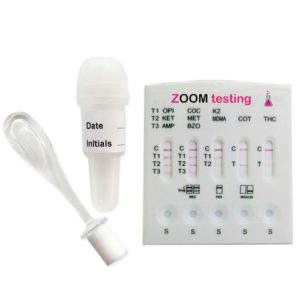When applying for life insurance, one of the first things you may have to do is to take a nicotine detection test. Nicotine is found in chewing tobacco and cigarettes and is the chemical responsible for the addictive nature of these products. When testing for nicotine levels in an individual there are a variety of methods that can be used (typically gas-liquid chromatography) but it is actually the detection of cotinine that reveals the most about a person’s exposure to cigarettes.
When nicotine is absorbed into the body, whether by inhaling smoke (by smoking a cigarette or second-hand smoke) or chewing tobacco, the liver begins to process, metabolise, and break down the nicotine. During this process a metabolite called cotinine is formed. What makes cotinine so important to nicotine is the fact that it has a half-life that is nearly 10 times as long as nicotine itself. Detecting nicotine and cotinine to determine smoking habits for life insurance evaluations can be done in a variety of ways including:
Hair Testing
Hair samples can detect nicotine levels up to 90 days prior to testing, making it valuable for long-term assessment of smoking habits. This method is particularly useful for determining patterns of use over time, as nicotine and its metabolites become trapped in the hair shaft as it grows. However, hair testing is generally more expensive than other methods and may not be as effective for detecting very recent nicotine use.
Using hair samples to detect nicotine can be important in long-term reporting because it can reveal nicotine levels as far back as 10 days before the user takes their sample, but on the other hand it can also be very expensive.
Saliva Testing
Saliva testing offers a non-invasive and cost-effective method for detecting recent nicotine use. It can typically detect nicotine and cotinine within minutes to hours after consumption. This method is particularly useful for on-the-spot testing, such as in workplace settings. However, it has a relatively short detection window compared to other methods, usually only up to 24-48 hours after last use.
When testing for nicotine levels with saliva, it gives the tester a very straight-forward and non-invasive testing method that is more cost-effective than hair samples. The downside, however, is that saliva testing doesn’t provide much history so a light smoker who just had a cigarette before their test can appear to have the same habits as someone who smokes 2 packs a day.
Urine Testing
Urine testing is the most common and preferred method for nicotine detection due to its balance of accuracy, cost-effectiveness, and ease of use. It can detect cotinine, the primary metabolite of nicotine, for up to 2-4 days after last use in most cases. Urine tests are particularly effective at distinguishing between active smokers and those exposed to secondhand smoke, making them valuable for both medical and insurance purposes.
Urine testing is the overall preferred method for measuring someone’s smoking habits because it can easily differentiate passive smokers from active smokers. Much cheaper than blood sampling, cotinine levels can easily be detected to not only get a picture of long-term smoking history but also determine if a user smokes often or is exposed to small amounts of second hand smoke on a daily basis.
The Zoom Testing Nicotine Test Kit detects cotinine in urine within hours of using the drug and possibly up to 2-4 days after use (depending on the individual and amount of use). The results obtained using this nicotine test kit are very reliable and can be read within five minutes. This test is a great way for testing for smoking.
Blood Testing
Blood testing is the most accurate method for detecting nicotine and its metabolites, providing a precise measurement of cotinine levels in the body. This method can differentiate between recent use and long-term exposure, making it valuable for clinical research and detailed health assessments. However, blood testing is more invasive, time-consuming, and expensive compared to other methods, which limits its practical applications in routine screenings.
One of the most effective ways to detect cotinine, using blood samples for testing a person’s smoking history can be a very lengthy process. The blood first has to be drawn, and then it has to go through extensive processing in the lab to separate different proteins for testing. Because it is so labour intensive and takes so long, it can be a lot more expensive than both saliva and urine testing.
Comprehensive Drug Testing Solutions
While this article focuses on nicotine testing, it’s worth noting that modern drug tests can detect a wide range of substances simultaneously. Zoom Testing, UK drug testing experts, offers a 10 Panel Saliva Drug Test that not only detects cotinine (the primary metabolite of nicotine) but also screens for nine other commonly abused drugs. This test can identify the presence of amphetamines, benzodiazepines, cannabis, cocaine, MDMA (Ecstasy), ketamine, methamphetamine, opiates, and even synthetic cannabis.
This comprehensive approach is particularly valuable for workplace testing or legal scenarios, such as roadside drug testing. The saliva test offers quick results, typically within 10 minutes, and is difficult to adulterate, making it a reliable choice for on-the-spot testing. By detecting cotinine, which has a longer half-life than nicotine itself, the test provides a more accurate picture of a person’s smoking habits or exposure to nicotine. Whether you’re an employer maintaining a safe workplace, a healthcare provider monitoring patient compliance, or a concerned individual, this versatile test kit from Zoom Testing offers a convenient and effective solution for multi-drug screening.
Photo by Anthony Cunningham for Zoom Testing
This post was originally published in 2013. It was last updated in October 2024.
Zoom Testing is a leading UK drug testing company and a supplier of Drug Test Kits.
You May Also Like:






